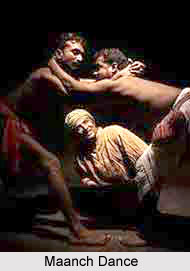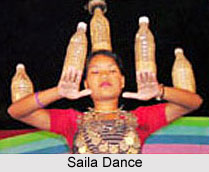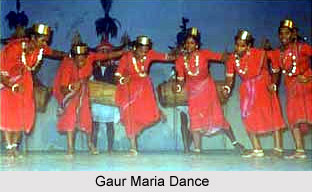 Folk Dances in Central India are of various styles and forms and they reflect the regional spice of the central states. The term folk dance is reserved and is mainly kept for dances which are, to a major degree bound by tradition. The multi-cultural country of India has also seen the development as well as growth of folk dances till date.
Folk Dances in Central India are of various styles and forms and they reflect the regional spice of the central states. The term folk dance is reserved and is mainly kept for dances which are, to a major degree bound by tradition. The multi-cultural country of India has also seen the development as well as growth of folk dances till date.
Folk Dances in Madhya Pradesh
The state of Madhya Pradesh can be termed as a cultural museum of India. The place not only unities many religions in its lap, but is also home to some of the most prominent tribal communities of the country. These tribals and aborigines of Madhya Pradesh have contributed to the rich culture saga of the place; intrinsically blending their indigenous cultures taints large netting pots.
Maanch: Maanch is a lyrical folk drama and a form of operatic ballet that is popular in Malwa in Madhya Pradesh. "Maanch" means the stage or place of performance and as an indigenous and distinct folk-form.
Gaur Maria Dance: Gaur Maria dance is one of the important dances of Bison Horn Marias of Abhujmaria plateau in Madhya Pradesh. This is a beautiful and joyful dance and is basically performed as an invocation on the occasion of marriages. This spectacular dance symbolizes the hunting spirit. The word `Gaur" means a ferocious bison. The invitation for a dance is given by sounding a bamboo trumpet or a horn. Wearing head dresses frilled with stringed `cowries` and plumes of peacock feathers fastened to them, men with flutes and drums make their way to the dancing ground. Women adorned with brass fillets and bead necklaces over their tattooed bodies soon join the assemblage.
Charkula Dance: Charkula Dance is a dramatic dance performance that is visually attractive. The dance owes its birth to Lord Krishna era. In the performance of Charkula, veiled women balance a large multi-tiered circular wooden pyramid on their heads and dance in various steps. The wooden pyramid is lighted with 108 oil lamps. These women dance on the `Rasiya` songs of Lord Krishna. Charkula dance is especially performed on the third day after the Holi festival, which is the Dooj, since this was the day, when Radha, was born.
Lava Dance: Lavani is indeed one of the most important folk dance forms that originated in the arid region of Maharashtra and Madhya Pradesh. Lavani enlaced with its color, dream and effervescence is somewhat like an escape to the land of beauty and love.
 Tertali: Tertali is a folk dance of the Kamar in Madhya Pradesh where two or three women of the tribe sit on the ground and initiate the dance performance. Small metal cymbal called `Mangiras` is tied on different parts of their bodies. They also carry a cymbal in each hand and strike them in rhythm. The head remains covered with a veil. Gnashing a small sword between their teeth and balancing a pot on their heads, they vigorously bellow the boat of the dance.
Tertali: Tertali is a folk dance of the Kamar in Madhya Pradesh where two or three women of the tribe sit on the ground and initiate the dance performance. Small metal cymbal called `Mangiras` is tied on different parts of their bodies. They also carry a cymbal in each hand and strike them in rhythm. The head remains covered with a veil. Gnashing a small sword between their teeth and balancing a pot on their heads, they vigorously bellow the boat of the dance.
Lehangi: Lehangi is a folk dance of the Banjara and Kanjar tribe of the Bhopal commissary. It is performed during the blossoming monsoon period. The Banjara tribe also performs this dance during the festival of "Rakhi". Young men hold sticks in their hands and rhythmically beat them while dancing in various acrobatic tricks that lend a dramatic touch to the performance.
Akiri: Akiri dance is a trademark of the cattle herders of Gwalior. The dance also has religious overtones as various communities of Gwalior who performed this dance are considered to be the descendants of lord Krishna. People belonging to the Ahir, Gwala, Rawat, Beat and Baredi communities generally perform Akiri.
Baredi or Yadav Dance: Baredi is an important folk dance of the Gwalior District. Starting from Diwali, the dance is performed till the day of "Kartik Purnima" A host of musical instruments like dholak, Jhang, Manjira mridang and daphil imparts the tribal beat as the dancers perform and move around in circles. The performers are clad in dhotis accessorized with peacock feathers.
Muria Dance: The Murias are trained in the Ghotui of all types of their community dances. Before any dance is commenced at a wedding or a festive occasion, the Murias first worship their drums. Often they begin with an invocation to `Lingo Pen`, the phallic deity of the tribe and the founder of the Ghotul institution. To a Muria, Lingo Pen was the first musician who taught the art of drumming to the tribal boys. The dancing site is chosen near the Ghotul compound.
Other important dance forms of Madhya Pradesh are Saila dance, Karma dance, Matki, Aada, Khada nach, Phulpati, Grida dance, Selalarki, Selabhadoni etc.
Folk Dances in Chattisgarh
Culture of Chhattisgarh is immersed in varieties of dance forms, mainly due to the number of tribes residing in the vast expanse of the state. To perform the Folk dance of Chhattisgarh people use various types of instruments such as Dholak, Manjira, Mandar , etc.
Saila Dance: In the month of Aghan, the villagers go to the adjoining villages to perform the Saila Dance. The group of Saila Dancers goes to each house and performs this dance. Saila in its simplest form is also performed as the Dussehra dance by the Baigas before festival of Diwali. The Saila dance is a stick-dance popular among the people of Sarguja, Chhindwara and Baitul districts.
Raut Nacha: Raut dance is a dance form performed by Yadava; a particular caste, as they are in a perpetual faith to be the descendents of Lord Krishna. Their amorous dance form acts as a symbol of worship to Krishna. They perform the dance at the time of `devudhni ekadashi`.
Karma Dance: Karma Dance is generally performed by tribal groups like Gonds, Baigas, and Oraons in Chhattisgarh. This dance form marks the end of the rainy season and the advent of spring. Both men and women participate in the dance following a lead singer.
 Sua Nacha: Sua Nacha is usually called a parrot dance. It is performed during Goura"s wedding. The artists sing and move, accompanied by loud applause. The women perform this dance while keeping a parrot in the center.
Sua Nacha: Sua Nacha is usually called a parrot dance. It is performed during Goura"s wedding. The artists sing and move, accompanied by loud applause. The women perform this dance while keeping a parrot in the center.
Pandavani: It is the dark horse of the Chhattisgarh folk dance. The art portrays the account of Pandavas in Mahabharata. Teejan Bai from Chhattisgarh is one of Pandvani"s most famous artists who have received various awards like Padma Shri, Padma Bhushan etc.
Panthi Dance: This is a prominent custom of the Satnami community of Chhattisgarh. The community celebrates the anniversary of the birth of Guru Ghasidas in Maghi Purnima. The rich cultural heritage and traditional legacies of the tribal groups of the Durg region are clearly represented through this form of dance.
Raut Nacha: Raut Nacha is also known as the Cowherds Folk Dance. Chhattisgarh"s cowboys are the main artists of this art form. The scenes show the fierce fight between King Kansa and the cowboys in that area. The cowboys belonging to Yadava community represent Lord Krishna as their almighty.
Jhirliti: One of the famous Bastar dance is Jhirliti. A lesser-known dance form, it is difficult to classify as an established dance form due to the lack of a fixed pattern. Halloween as a ritual is celebrated by children in Bastar region. When the sun goes down, the children dress in rags and worn-out costumes. Their faces become nothing less than a canvas with chalk, charcoal, and powdered rangoli spread on it. They perform Jhirliti in circles in front of all houses in the town, after which they are given ration as a sign of gratitude for the dance.
Rahas Dance: Rahas dance is performed during festivals in Chhattisgarh. It is mainly performed in the Dhamtari district. Rural people represent the dance with great enthusiasm wearing traditional hats and costumes. The central theme of the dance is Rash Lila of Krishna and Radha.
Gendi: Gendi dance is pure fun. The dancers are mounted on two long bamboo poles or on any firm pole and maneuver through the crowd of other Gendi (pole) mounted dancers. Dancers bang on the ground, keeping an excellent balance while swaying with tribal acoustics and percussions. This is a folk dance that has managed to keep its tradition alive.
India has always been the land of variety of dances with folk dances constituting an important part. An essential part of the tradition and culture of India, different region of the country upholds different types of folk dances, all unique in itself.



















